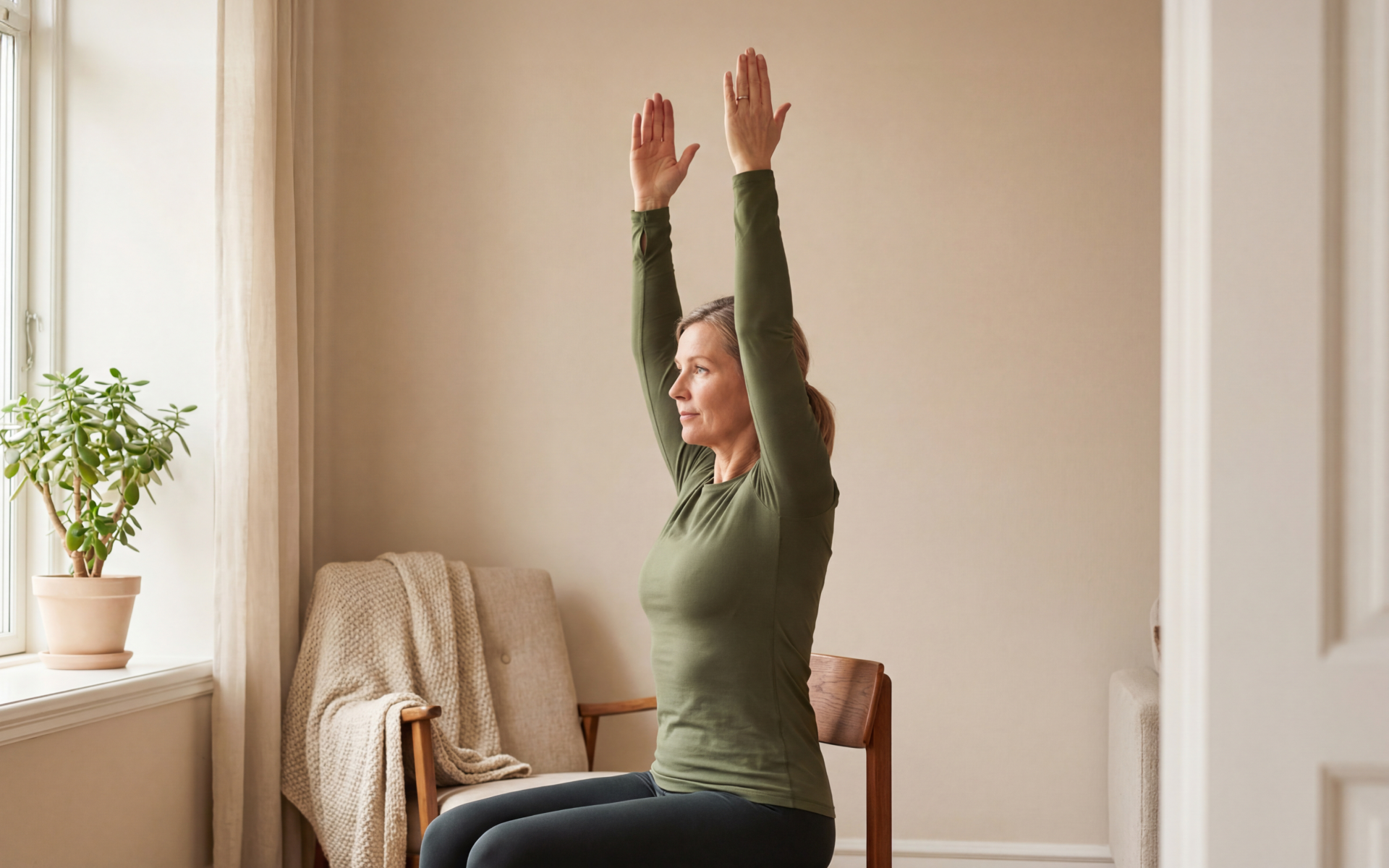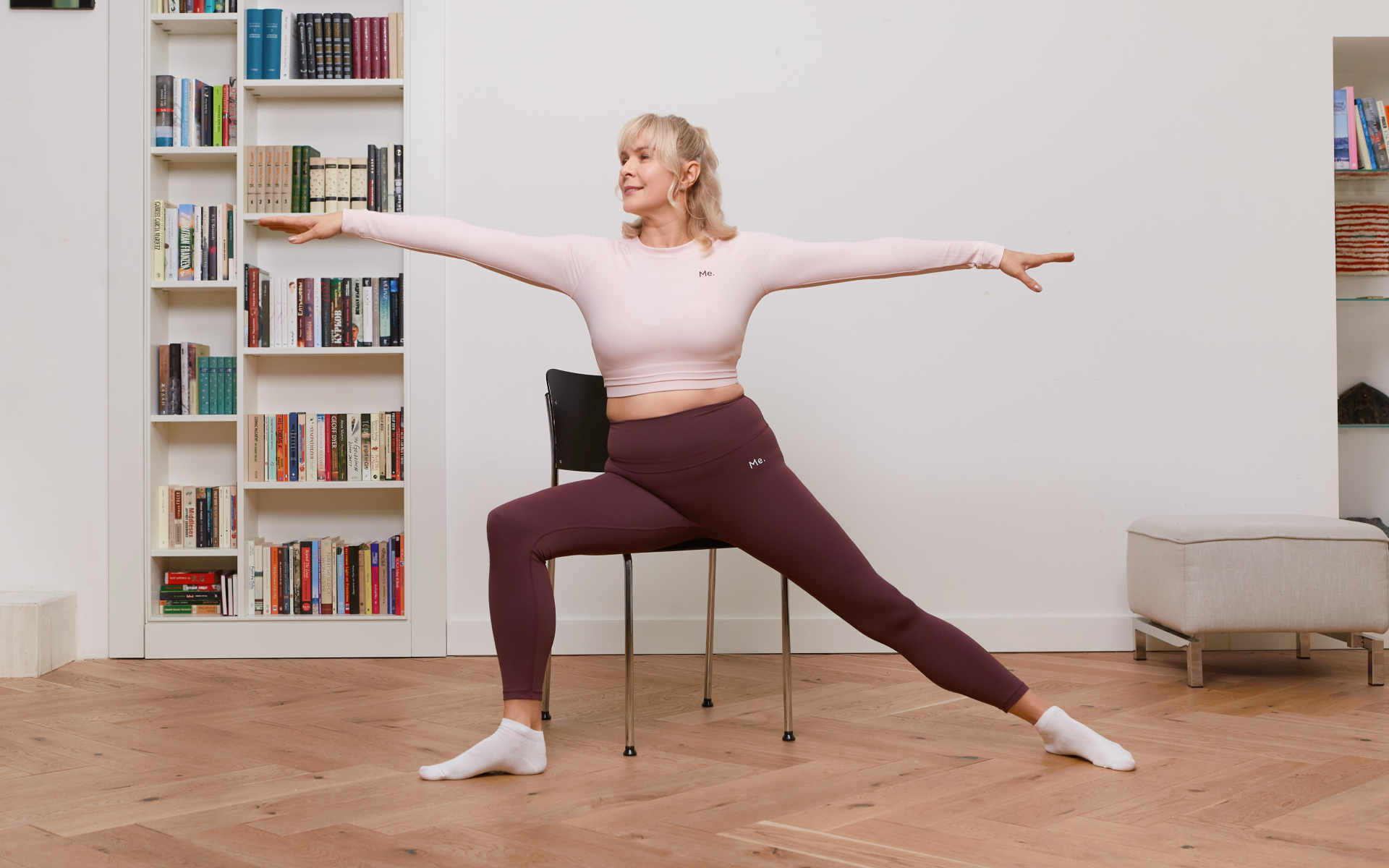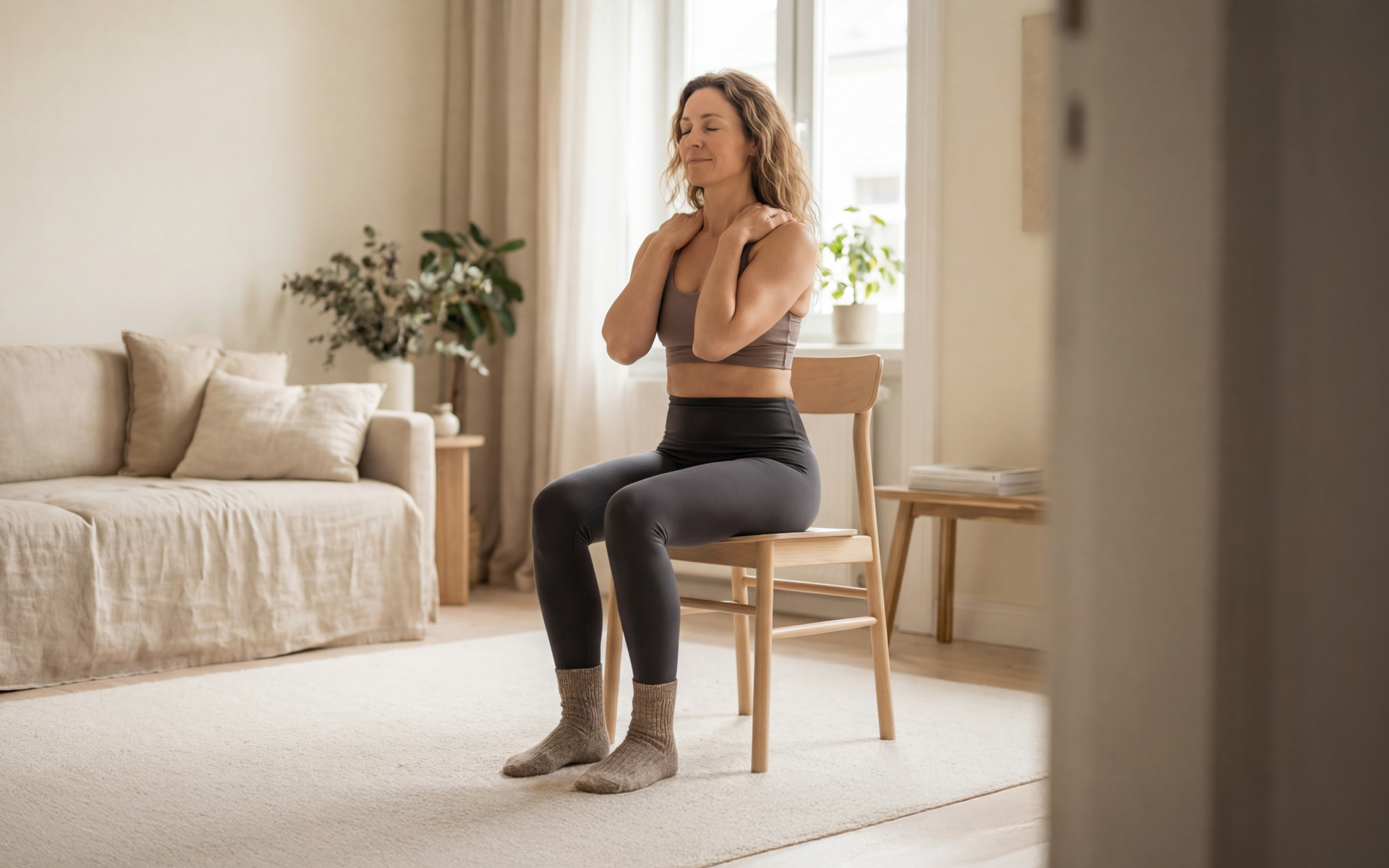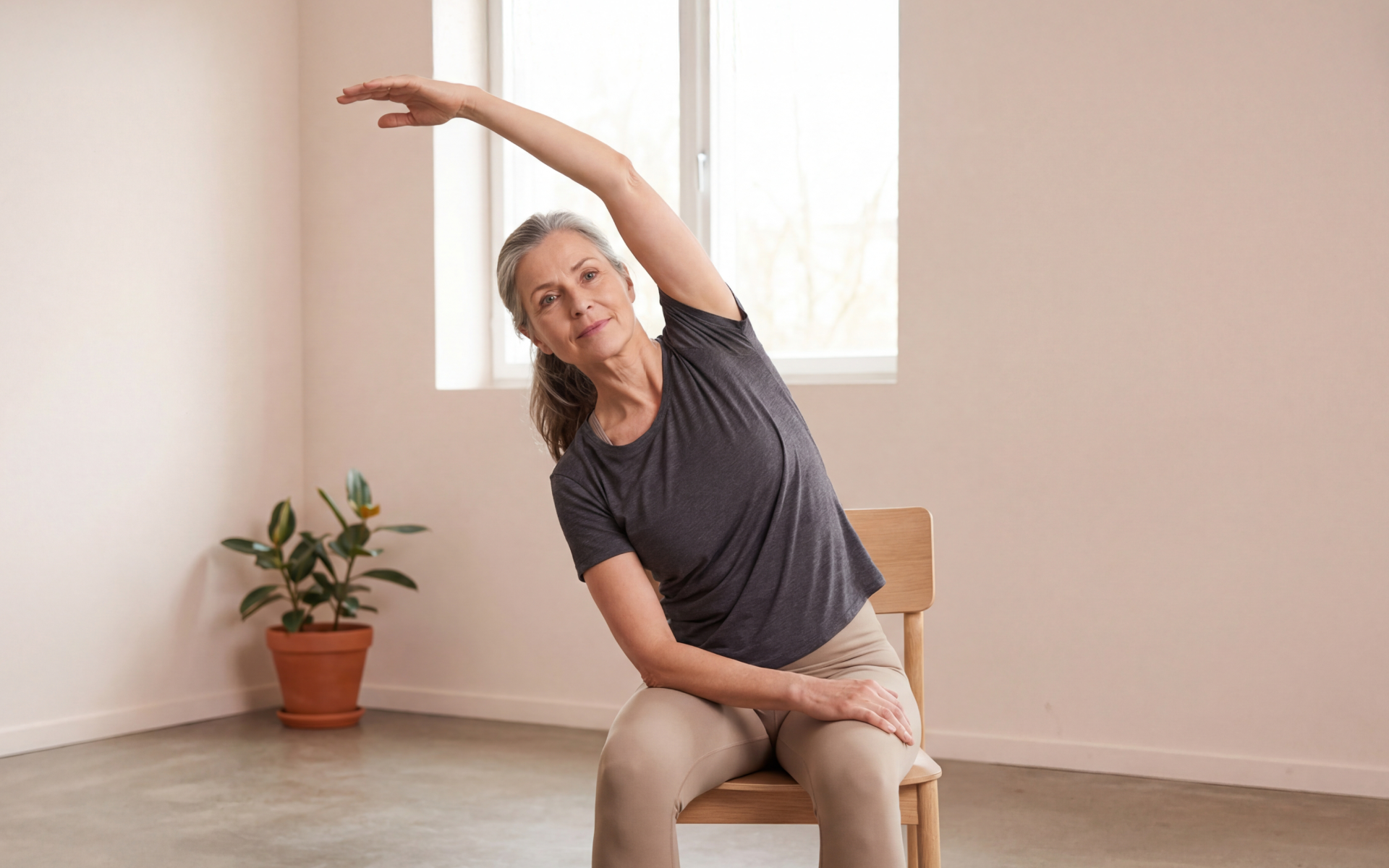When compared to younger people, many older adults live rather sedentary lifestyles. While this is understandable as their bodies may not be as strong as they once were, it is encouraged that they should remain active in some way.
In a study published in the Scandinavian Journal of Medicine & Science in Sports in 2020, researchers found that seniors who lived physically active lives experienced healthier aging trajectories, better quality of life, and improved cognitive functioning.
They also found out that these seniors had a lower risk of all-cause and cardiovascular mortality, breast and prostate cancer, fractures, recurrent falls, ADL disability with functional limitation and cognitive decline, dementia, Alzheimer’s disease, and depression (7).
Chair exercises for seniors is one such way to ensure that older adults engage in physical activity. Read on to learn more about seated exercises for seniors, equipment needed to do them, recommended duration for a session, and much more.
Why Should Older Adults Engage in Chair Exercises for Seniors?
Chair exercises for seniors benefits can be summarized in two main points. Engaging in such workouts helps older adults:
- Become more physically active – something that is recommended to all, regardless of age
- Boosts their health – both physically and mentally which helps improve their quality of life
In a practice guideline published in 2009 in the Medicine & Science in Sports & Exercise journal, experts from the American College of Sports Medicine recommended that older adults should engage in regular exercise.
The experts stated that while exercise cannot stop the physical process of aging, it has the ability to minimize the physiological effects of a sedentary lifestyle and increase active life expectancy by limiting the development and progression of chronic disease and disabling conditions (1).
However, this is not the only publication to have stated this. Over the years, more articles have come out in support of more physical exercise in older adults.
- In an article published by the National Institute of Aging in 2020, it was stated that physical exercise is essential in maintaining mobility in older adults. As we get older, our mobility may decrease, which leads to a decrease in muscle mass and bone density. These changes increase the risk of falls and fractures.
Yanking yourself back in shape has never been so easy with our game-changing fitness app! Start transforming your life with BetterMe !
When the mobility of older adults is impaired, they lose their independence, which cuts them off from their social lives and forces them to stay at home, reducing their quality of life, which increases their likelihood of falling ill, being hospitalized, disability, and even death (12).
- Centers for Disease Control and Prevention also advocates for regular physical activity in older adults. Aside from preventing and delaying many health issues that come with old age, they also state that doing this can improve functionality as exercise helps build muscle – boosting independence and making day-to-day tasks easier (9).
- In a more recent study looking at the challenges in mobility in older adults, researchers highlighted a healthy lifestyle and exercise as some of the things that could help reduce mobility issues in seniors (5).
Therefore, exercise, regardless of type, is essential in older adults. From aerobics and resistance training to flexibility and balance training, seniors should be encouraged to do it all – just be sure to tailor each exercise to the person’s abilities and goals (2, 3).
It is also important to note that seated chair exercises for seniors are also considered low-impact exercises. Research on such workouts has shown that low-impact exercises are good for older adults and kinder and safer for the joints, which could reduce the risk of developing rheumatoid arthritis (8, 11).
How Often Should a Senior Do Chair Exercises?
Older adults should do chair exercises for seniors at least twice a week. When it comes to engaging in physical activity as a whole, experts and researchers suggest that it is best if older adults engage in some kind of physical activity at least 3 times a week – with 5 times a week being the best option.
They also state that older adults should dedicate at least two days a week to strength-building workouts (9, 10, 13). It should be noted that while a 30-minute chair exercises for seniors routine can be modified to include cardio/aerobic moves, such exercises are largely anaerobic, muscle-strengthening activities.
With this in mind, we would advise you to be conscious of incorporating both aerobic (cardio) and anaerobic (strengthening) activities throughout your workout week, and not neglecting either type.
BetterMe has incredible wheelchair fitness workouts – cardio, core, upper body, and more – that can be done by seniors with mobility issues.
What Is the Best Chair to Use for Chair Exercises?
The best thing about seated exercises is that they can be done in virtually any space. However, as with other traditional workouts, having the right equipment will help you achieve your goals faster and could also help reduce the risk of injury.
So which is the best chair to use when doing chair exercises for seniors?
The National Health Service advises that when doing sitting exercises, you should opt for a solid, stable chair without wheels. If you have adequate sitting stability, you should also avoid any chairs that come with armrests as they can hinder your movements when you perform certain moves.
It’s also important to make sure that when you sit on said chair, your feet are comfortably flat on the floor and your knees are bent at about 90 degrees (14). If not, the chair may be too tall or too short for you, so you should then switch it out for something more comfortable that meets the given specifications.
What Is the Best Seated Exercise?
There is no one seated exercise that beats all the rest. A good chair exercise routine is one that mixes a number of exercises that target different areas of the body. This will allow for a fantastic full-body workout.
Here are 6 simple beginner seated exercises that you can use in a 10-minute chair routine for seniors.
6 Beginner Chair Exercises for Seniors
If you wish to increase this routine from 10 minutes to 30 minutes, or even an hour, simply do more sets of each exercise and/or increase the number of reps done per exercise for each set.
Seated Marches
This is a great example of a seated cardio exercise. As with the standing version, this exercise targets the lower body and can be used as a warm-up.
- Sit on your chair, about halfway on the seat. Don’t lean back or arch your back – keep your spine straight and pull your belly button to your spine to tighten the core muscles.
- Your knees should be at a 90-degree angle with your feet flat on the floor.
- With your core engaged, press one leg into the floor, while slowly marching the other leg up.
- Hold the elevated leg in the air for a few seconds then slowly lower it to the ground.
- Alternate legs and repeat the same movement.
- If you’re able, aim to do this for a full minute, using a watch or timer on your phone to keep track of the time.
- To increase the cardiovascular challenge of the exercise, increase the speed of your marches, making sure to keep the movement under control.
Sitting Punches
Boxing is a great upper-body workout. High-intensity boxing workouts have been shown to improve fitness and help with fat loss, improve cardiovascular health, and boost weight loss (15). This type of exercise can even do wonders for your mental health, helping reduce symptoms of anxiety, depression, PTSD, and schizophrenia (4).
While older adults may opt to not do seated punches at high intensity, it’s still a good upper-body exercise that can help improve hand-eye coordination.
- Sit on the edge of your chair with your feet flat on the ground approximately shoulder-width apart.
- Lift both arms up, bringing them in front of your face, and make your hands into fists.
- Twist your torso to your right and extend your left arm out in front of you as you twist.
- Pull your left elbow back, returning to the starting position.
- Repeat the motion with the right arm. That’s one rep.
- Do this for 8 to 10 reps.
Sitting Knee Extension
In addition to benefiting hamstring flexibility and active range of motion of the knee joint, this exercise also may improve quadricep strength for deconditioned individuals. The quadriceps play a vital role in many daily living activities, including walking, ascending and descending stairs, standing up, and sitting down.
- Scooch all the way back in your chair until you feel the backrest. Keep your spine straight and core engaged.
- Place your arms on either side of the seat of your chair and hold on tight.
- Slowly straighten your right leg out in front of you, lifting it until the knee is straight.
- Hold for one second, then slowly re-bend the leg until your foot is resting on the floor again. This is one rep.
- Repeat 10 reps on the right leg and then switch to the left leg to repeat the process. Alternatively, you can alternate both legs, but make sure that each leg/knee does an equal number of reps.
Read more: 4 Easy Chair Workouts for Abs You Can Do At Your Desk
Seated Shoulder Press
This is a great exercise that helps strengthen your shoulders.
- Sit tall in your chair, keeping your feet flat on the ground approximately shoulder-distance apart.
- Hold a light dumbbell, a filled water bottle, or the end of a resistance band in each hand at your shoulders, your elbows bent and your palms facing away from you.
- Press your arms straight up overhead, extending your elbows. Hold and then carefully lower your hands back to the starting position.
- This is one rep. Do 10 to 12 reps for one set.
Seated Calf Raises
If you want to strengthen your calves, this is the exercise for you. Seated calf raises help strengthen the muscles that are involved in the push-off portion of walking, which improves gait sequencing and reduces the risk of falls.
- Sit down in a sturdy chair with your knees at 90 degrees and your feet flat on the floor.
- Press into the balls of your feet and lift your heels up as far as you can.
- Hold this position for 1 second, then slowly lower your heels to the floor.
- This is one rep. Do 12 to 15 reps for 1 set.
Seated Rows
Another good upper-body exercise that targets the back muscles is the seated row.
- Sit upright in your chair with a resistance band anchored to a door in front of you. Ensure the anchored end of the band is somewhere between eye and chest level. Make sure the door is latched firmly shut!
- Grab the handles or ends of the resistance band, starting with your arms straight out in front of you. The band should have enough tension in it so that when your arms are fully extended in the starting position, you feel some resistance.
- Bend your elbows and pull the band towards you until your hands touch your ribcage. Squeeze your shoulder blades together as you pull.
- Slowly return to the starting position.
- This is one rep. Do 10 reps for 1 set.
What Burns Fat While Sitting?
What many people don’t know is that your body burns calories throughout the day whether you’re moving, sitting, or sleeping. The energy expenditure needed for your body to perform its basic functions is known as your basal metabolic rate (BMR). The number of calories you burn as a result of your BMR is dictated by many factors including your height, weight, age, gender, lean body mass percentage, genetics, and underlying conditions.
Whether or not the calories you burn as a result of your basal metabolic rate can keep you at a healthy body weight is dependent on the calories you take in. For most of us, we consume more calories than we expend via our BMR. In addition, a healthy weight doesn’t necessarily mean a healthy lifestyle.
You can be severely deconditioned even though you fall within a normal body weight for your height and gender. For this reason and many others, it’s important to incorporate exercise into your daily routine, whether through structured workouts or through active daily activities.
Is a Chair Yoga Workout Plan Good for Seniors?
Yes, it is.
Chair yoga is another example of seated workouts that can work well for seniors who want to improve their fitness, health, mobility, flexibility, and balance. If you’re looking for a good chair yoga guide, BetterMe has gentle chair yoga beginners and seniors routines on its app.
The exercises last anywhere between 8 to 30 minutes and can help improve posture, mobility, core strength, and ab growth.
If you wish to cinch your waist, tone up your bat wings, blast away the muffin top – our fitness app was created to cater to all your needs! BetterMe won’t give excess weight a chance!
FAQs
Can I lose weight doing chair exercises?
Yes, you can. They do this by burning calories during the workout and increasing your muscle mass, which increases your basal metabolic rate. This allows you to keep burning calories long after the workout is done. Ultimately, weight loss is dependent on caloric deficit and genetic factors. Any form of exercise will improve caloric expenditure, but a well-rounded, healthy diet and lifestyle is essential for weight loss.
Remember that while weight loss due to such exercises is good, their benefits go beyond this. Because the exercises contribute to improvements in muscular strength, balance, and gait speed, researchers believe that such routines can help boost the physical and mental health of older, pre-frail adults (6).
What is the 7-minute sit exercise routine?
This is a seated workout routine that is done for just 7 minutes. Such routines can be for the upper body, core, lower body, or full body sessions.
Which sitting position burns the most fat?
As previously stated, there isn’t one sitting exercise that will lead to more fat burning than all others. If you want to effectively burn fat via a workout routine, the routine must include a variety of exercises that target different muscles. This helps with calorie burning, which may lead to more fat loss.
What is the best exercise for seniors to strengthen their legs?
The best exercise for seniors to strengthen their legs is highly dependent on the goals of the individual and their current fitness level. For someone who is very deconditioned, the best lower-body exercise may be a basic seated exercise that they can perform without supervision or risk of falling. For someone with a high fitness level, the best lower-body exercise is likely not going to be a seated one. Squat variations are highly functional, incorporate numerous muscle groups, and can be progressed and regressed for nearly any fitness level.
The Bottom Line
Encouraging participation in chair exercises for seniors is a good and low-impact way to get older adults to live less sedentary lives. This can help increase their social circles – if the workouts are done in group settings – and boost their health, functional fitness, flexibility, general quality of life, and much more.
DISCLAIMER:
This article is intended for general informational purposes only and does not serve to address individual circumstances. It is not a substitute for professional advice or help and should not be relied on for making any kind of decision-making. Any action taken as a direct or indirect result of the information in this article is entirely at your own risk and is your sole responsibility.
BetterMe, its content staff, and its medical advisors accept no responsibility for inaccuracies, errors, misstatements, inconsistencies, or omissions and specifically disclaim any liability, loss or risk, personal, professional or otherwise, which may be incurred as a consequence, directly or indirectly, of the use and/or application of any content.
You should always seek the advice of your physician or other qualified health provider with any questions you may have regarding a medical condition or your specific situation. Never disregard professional medical advice or delay seeking it because of BetterMe content. If you suspect or think you may have a medical emergency, call your doctor.
SOURCES:
- American College of Sports Medicine position stand. Exercise and physical activity for older adults (2009, pubmed.ncbi.nlm.nih.gov)
- Benefits of exercise for older adults. A review of existing evidence and current recommendations for the general population (1992, pubmed.ncbi.nlm.nih.gov)
- Benefits of Exercise in the Older Population (2017, pubmed.ncbi.nlm.nih.gov)
- Boxing as an Intervention in Mental Health: A Scoping Review (2023, ncbi.nlm.nih.gov)
- Challenges and opportunity in mobility among older adults – key determinant identification (2023, bmcgeriatr.biomedcentral.com)
- Combined Chair-Based Exercises Improve Functional Fitness, Mental Well-Being, Salivary Steroid Balance, and Anti-microbial Activity in Pre-frail Older Women (2021, ncbi.nlm.nih.gov)
- Consequences of physical inactivity in older adults: A systematic review of reviews and meta-analyses (2020, pubmed.ncbi.nlm.nih.gov)
- Effect of Low-intensity Exercise on Physical and Cognitive Health in Older Adults: a Systematic Review (2015, ncbi.nlm.nih.gov)
- How much physical activity do older adults need? (2023, cdc.gov)
- How Older Adults Can Get Started With Exercise (2020, nia.nih.gov)
- Low-Intensity Physical Exercise Decreases Inflammation and Joint Damage in the Preclinical Phase of a Rheumatoid Arthritis Murine Model (2023, ncbi.nlm.nih.gov)
- Maintaining mobility and preventing disability are key to living independently as we age (2020, nia.nih.gov)
- Recommendations for physical activity in the elderly population: A scoping review of guidelines (2022, ncbi.nlm.nih.gov)
- Sitting exercises (2024, nhs.uk)
- The feasibility and effectiveness of high-intensity boxing training versus moderate-intensity brisk walking in adults with abdominal obesity: a pilot study (2015, ncbi.nlm.nih.gov)









